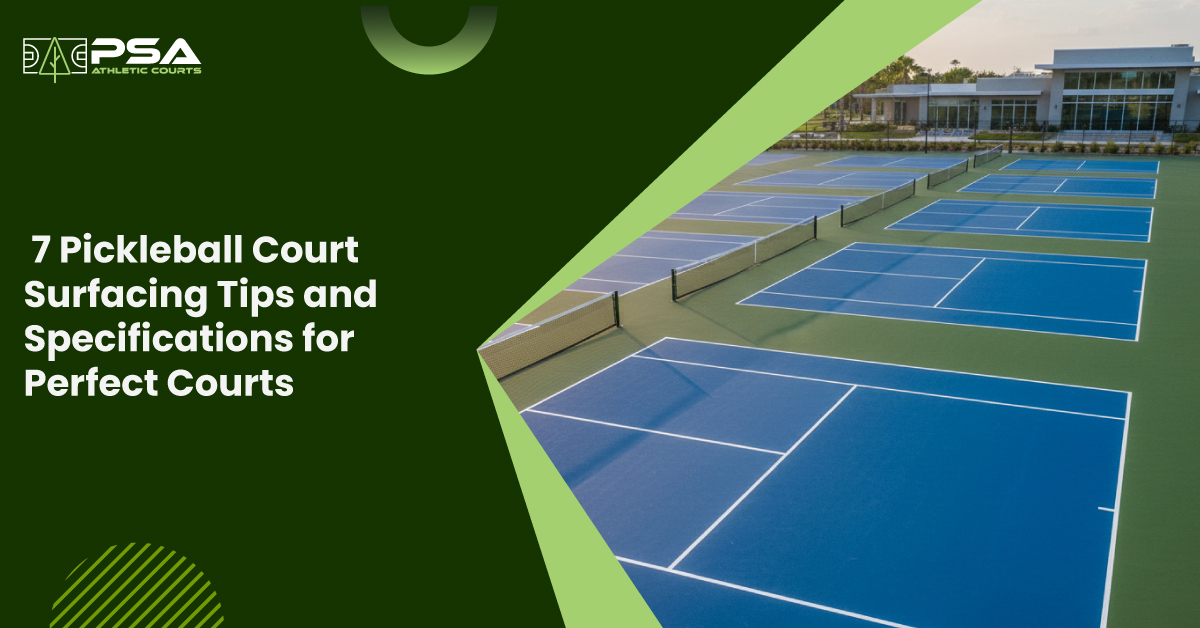When James Naismith first nailed a peach basket to the YMCA gymnasium wall back in 1891, he had one goal in mind to get the students moving in winters. Fast forward to today and precision is everything. From the three-point arcs, free-throw lines, and the exact width of the paint, a few feet here or there changes the game entirely.
From NBA, FIBA, NCAA to DIY courts, each court has its own dimensions, confusing new players and court owners alike. Which is why this guide by Pine State Court is here to break it all down for you.
In this blog on Basketball Court Dimensions 101, we will discuss everything about basketball court dimensions from full courts to indoor vs. outdoor courts, and how you can build a court that’s perfect to fit your needs. So, let’s get that ball moving!
Basketball Court Layout & Key Measurements
The standard basketball court layouts and measurements vary depending on where you are playing. Each authority from NBA to FIBA and NCAA has its own set of dimensions and rules. But don’t worry! Here’s a quick rundown of the different court dimensions for you:
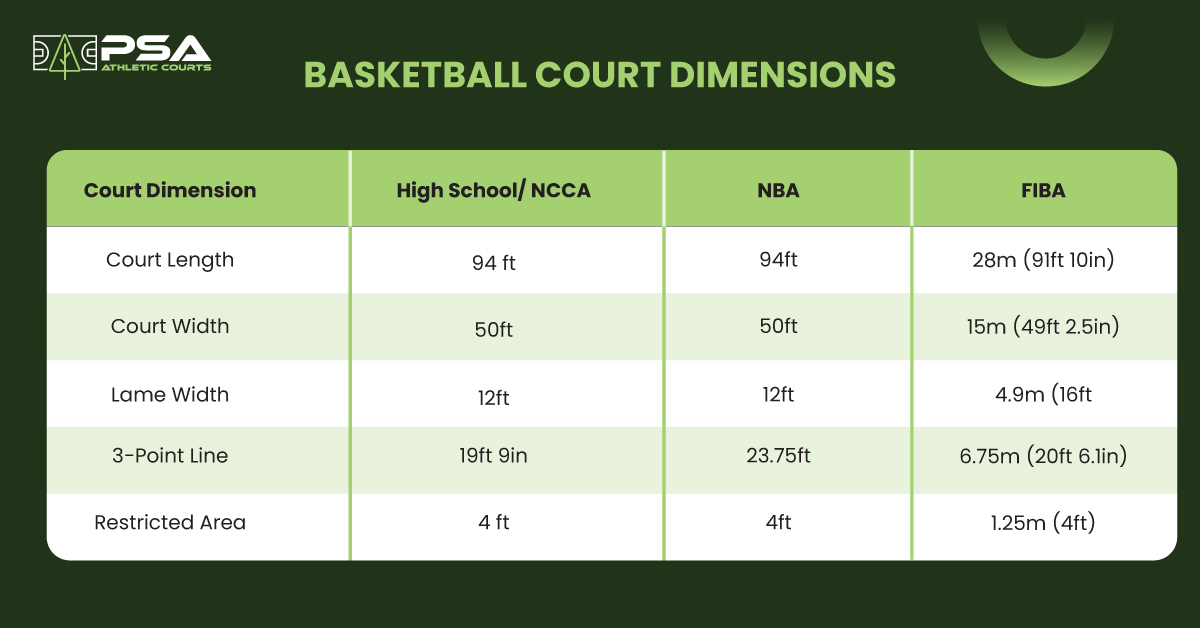
NBA Court Dimensions
The National Basketball Association or NBA has laid down its own specific guidelines for basketball court dimensions. As per NBA guidelines, the overall size of the court should be 94 feet long (sideline) by 50 feet wide (endline or baseline), with a division line running in the middle of the court.
The other areas of the court and their dimensions are given below:
- The three-point line
The three-point line is an arc which is 23 feet 9 inches away from the basket at the center, and 22 feet wide at the corners. It has a space of 3 feet from the sideline on each side.
- The free throw line/ foul line
The free throw line or foul line is a 16 feet wide line that runs parallel to the endline (or the baseline). It is 15 feet away from the backboard.
- The key/paint area
The key is 16′ wide and extends 19′ from the baseline to the top of the free throw circle.
- The hoop and backboard
The backboard is 6 feet wide and 3.5 feet long, it holds a basketball hoop of 18 inches (inside diameter) stationed 10 feet above the ground.
- The restricted area
It is a semicircular area under the basket which is 4 feet wide in diameter.
FIBA Court Dimensions
The FIBA (International Basketball Federation) court dimensions for basketball are slightly different from that of the NBA. These dimensions are utilized for The Olympics and other international matches. Here’s how FIBA court dimensions differ from NBA:
- The overall size of the court is 28 m (around 92 feet) long and 15 m (around 50 feet) wide.
- The three point line is 22.15 feet away from the basket and 21.65 feet wide at the corners.
- The key/paint area is 16 feet wide running parallel to the baseline.
- The NCSC (No Charge Semi-Circle), known as the restricted area by the NBA, is 4.1 feet in FIBA.
The hoop, backboard, and the free throw line dimensions are the same for both FIBA and NBA.
High School / NCAA Dimensions
The guidelines set by the National Collegiate Athletic Association or NCAA are quite different from that of NBA and FIBA. The high school and NCAA basketball court dimensions are:
- The overall size of a high school court is smaller, measuring 84 feet long and 50 feet wide while the NCAA court size is the same as that of the NBA.
- The three point line is 22.1 feet for men’s and 20.9 feet for women’s NCAA courts. The same for high school is 19.9 feet from the center of the basket.
- The key or paint area is 12 feet wide for both NCAA and high school courts.
- The high school courts lack a restricted area unlike the NCAA where it is a 3 radius.
The hoop, backboard, and the free throw line dimensions are the same for all of the courts i.e., NBA, FIBA, NCAA, and high school.
Now that you know the standard dimensions, you must be curious about building your own court and whether you can customize these dimensions.
Backyard or Custom Basketball Court Dimensions
While building a basketball court you have two options, to either build a complete professional court or get a custom basketball court designed to best utilize your outdoor space.
You know all about the professional basketball court dimensions (NBA, FIBA, and NCAA), the custom backyard basketball court dimensions however differ slightly based on how much space you own. The most common dimensions are 60×30 is good for a small half court. 30×30 is extremely tight — playable but only for shooting (not a full half-court key & 3pt line).
This space is a great investment for any property. It is not just a competitive playground but offers other perks of family bonding and social gathering too.
Indoor vs. Outdoor Basketball Court Considerations
Another decision court owners face is to decide whether to build the court indoor vs. outdoor. While the indoor courts offer year-round play and professional level surfaces, the outdoor courts bring fresh air, community bonding, and versatility to their credit.
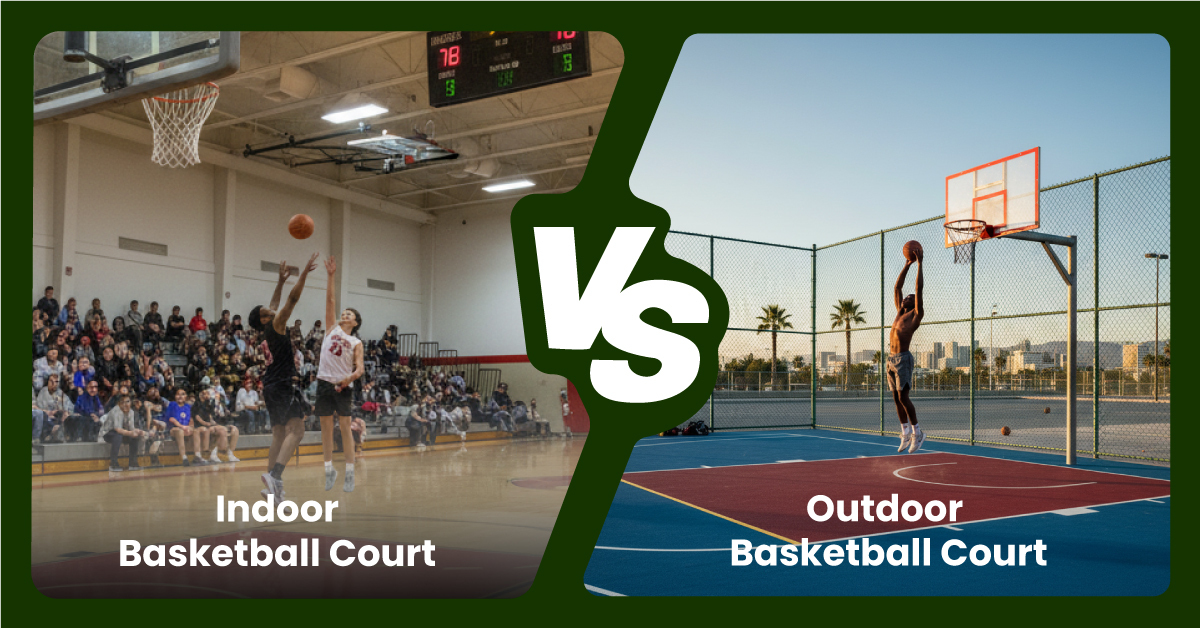
Choosing between the two isn’t just about space, it’s also about your lifestyle, budget, and how you want to play. If you too are facing this dilemma then here’s a pros and cons list to help your decide which one to choose from indoor vs outdoor basketball courts:
Indoor Basketball Court
Pros:
- Offer year-round play no matter the weather conditions.
- Professional hardwood surfaces provide competitive gameplay.
- Controlled lighting and climate conditions don’t affect the game.
- Longer lifespan for flooring and equipment.
Cons:
- Higher construction and maintenance costs.
- Requires large indoor space.
- Limited flexibility for building multi-athletics courts.
Outdoor Basketball Court
Pros:
- More affordable to build and maintain than indoor courts.
- Offer a community-friendly and social atmosphere.
- Can double as a multi-purpose space (for yoga and other physical activities)
- Fresh air and natural lighting are suitable for family games.
Cons:
- Weather can limit the playtime.
- Surfaces wear down faster (due to extreme weather-sun, rain, or snow).
- Less consistent bounce and grip due to easy court wear and tear.
- Requires more frequent maintenance and upkeep.
Basketball Court Planning Tips for Your Perfect Layout
Building a basketball court is nothing short of a transformative project with its careful planning, site preparation, surfacing, and to finally build the court. In order to ace this project, it is important to seek the expertise of professional basketball court designers.
At Pine State Courts, we excel at creating custom courts to build a space where you can play, bond, and train professionally. Here’s a quick run down of our basketball court planning tips for your perfect basketball court layout:
- Measure your space first and analyze it to know exactly how much room you have, to decide on a full, half, or custom-sized court.
- Prioritize the playing surface and compare the different surfaces. Amongst the options, concrete and asphalt are common for outdoor courts, while hardwood or synthetic materials work best for indoor basketball courts.
- Lay out the lines and markings carefully. Even on a half-court, proper three-point, free throw, and key markings, etc. are crucial to make the game more realistic.
- Add appropriate buffer zones by leaving extra space beyond the baseline and sidelines (minimum 3 feet) to prevent injuries.
- Invest in quality equipment, hoops, backboards, and surfacing to avoid constant repairs.
- Make the court your own by personalizing it. Use custom colors, logos, or team markings to build a court that’s uniquely yours.
- Don’t forget the lighting for both indoor and outdoor courts. LED lights extend the playtime into the evening and improve player safety.
Top Pitfalls to Avoid when Designing a Basketball Court
We understand how tiring the entire court building process can be but it will be equally rewarding when the players compete fiercely and safely while you cheer from the sidelines. To make sure your court is always ready for competitive plays, here are the top pitfalls that you should avoid when designing your basketball court:
- Not preparing the site properly
The foundation of any good athletic court is the site that it’s built upon. Improper levelling and not considering drainage are some small issues that turn bigger with time and can impact the player’s safety and longevity of the court.
- Choosing the wrong court surface
With plenty of options between hardwood, asphalt, concrete, and grass court, choosing the wrong surface can impact the traction and ball bounce, affecting the gameplay.
- Ignoring the buffer zones
It is not just the lines and markings that dictate the size of the court, it is equally important to consider leaving some extra space beyond the sidelines for player safety.
- Skipping on the court maintenance
Regular court maintenance is not just a precaution but a necessary ritual to ensure that your court stays in its top shape. Skipping maintenance can add to the basketball court resurfacing cost or necessitate rebuilding it from ground zero.
Design Your Custom Basketball Court
All that information and tips must have added to your excitement of getting started with your own project. If you are feeling a little lost by any chance, don’t worry! At Pine State Courts, all courts are built to perfectly align with your space and level of play.
Get started with your unique basketball court project with our interactive basketball court designer tool and customize the court by adding your own little tweaks.
Takeaway
Building a basketball court isn’t an easy one and done affair. What starts with the knowledge of court dimensions for NBA, FIBA, and NCAA, budget considerations, indoor vs. outdoor courts, and designing the basketball court layout is nothing without its proper maintenance and resurfacing.
At Pine State Courts, we have both expertise and experience of building professional grade and custom backyard basketball courts. Your partnership with us will lend you a court that’s ready for both competitive matches and recreational play. We also offer assistance in maintenance and resurfacing the court, contact us for more information.
Frequently Asked Questions
1. What are the dimensions of a basketball court?
The dimensions of a basketball court depends on which basketball league you are playing for. The NBA and NCAA court dimensions are 94 feet by 50 feet, for FIBA it is 92 feet by 49 feet, and for high school courts it is 84 feet by 50 feet.
2. What are the dimensions of a half court basketball?
The dimensions of a half court basketball as per the NBA guidelines is 47 feet by 50 feet. For backyard half courts, the general dimensions are 30 feet by 30 feet or 30 feet by 50 feet.
3. Is 30x30 big enough for a basketball court?
Yes, 30x30 feet is big enough for a basketball court and is a popular size for a backyard/ home court. Although the official NBA basketball half court dimensions are 47 feet by 50 feet, this size provides enough space for practicing shots and introducing kids to the game.
4. How many pickleball courts fit on a basketball court?
You can fit two comfortably; three if you overlap margins and space is tight. can easily fit on a basketball court. As a pickleball court measures 44 feet by 20 feet while a standard basketball court is 94 feet by 50 feet, this pace is big enough to fit three pickleball courts.
5. How much space is needed around a basketball court?
Leave 3′ minimum for safety at home; aim for 10′ clear space for competitive play.
DOWNLOAD OuR
FREE GUIDE
Stay on top of your court maintenance all year. Whether it's rain, snow, summer, or fall - we've got you covered with this complete guide.
Get a complete month-by-month breakdown to keep your outdoor courts safe, clean, and game-ready.
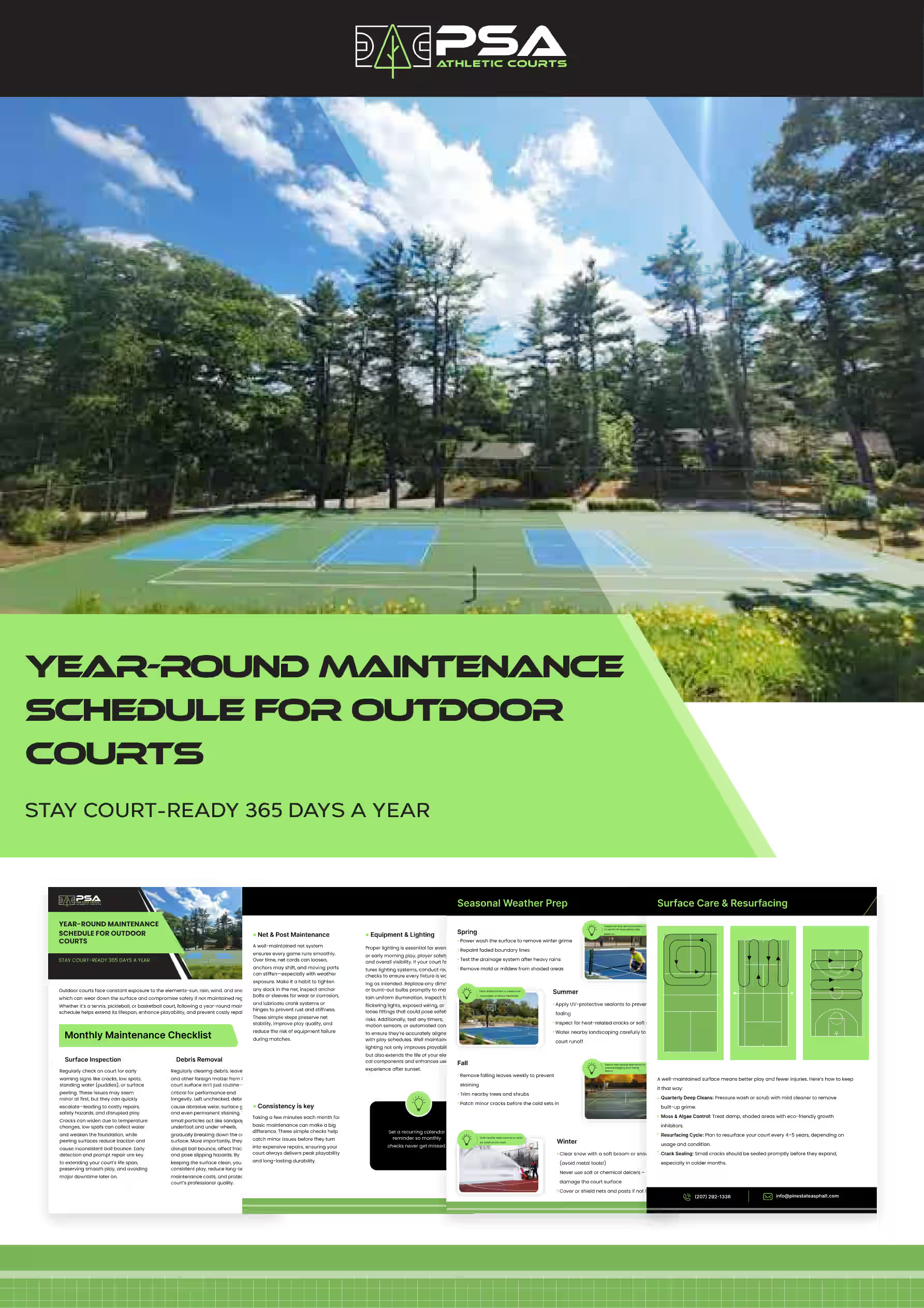


.jpg)

